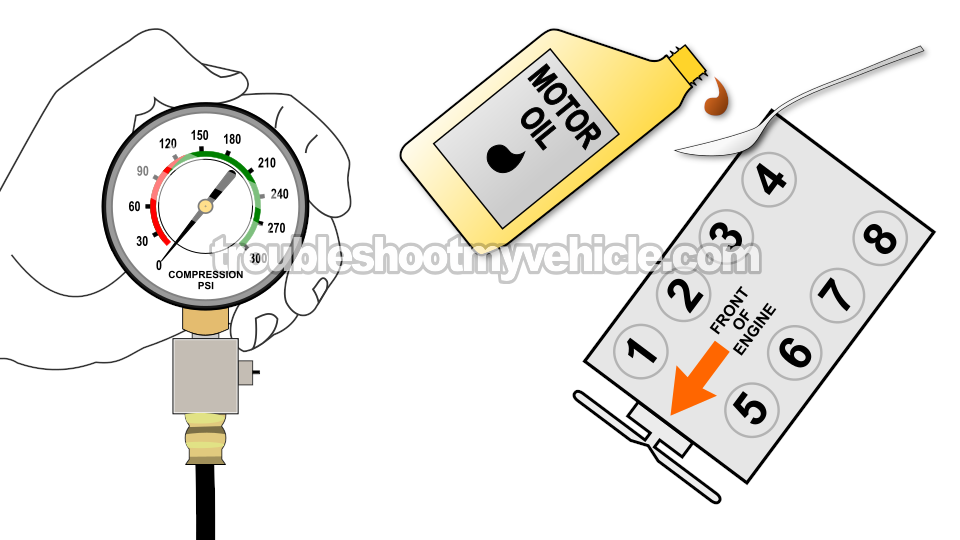
Although testing engine compression can be a process in itself, it's not that difficult. One thing that makes it easier is the fact that the spark plugs are quite accessible, as they need to be removed to test engine compression.
In this tutorial, I'll explain how to perform an engine compression test on the Crown Vic (Grand Marquis) and also how to interpret the results to determine if any of the eight cylinders have compression issues causing an engine performance problem.
Contents of this tutorial:
APPLIES TO: This tutorial applies to the following vehicles:
- 4.6L Ford Crown Victoria: 1992, 1993, 1994, 1995, 1996, 1997, 1998, 1999, 2000, 2001, 2002, 2003, 2004, 2005, 2006, 2007, 2008, 2009, 2010, 2011.
- 4.6L Mercury Grand Marquis: 1992, 1993, 1994, 1995, 1996, 1997, 1998, 1999, 2000, 2001, 2002, 2003, 2004, 2005, 2006, 2007, 2008, 2009, 2010, 2011.
Symptoms Of Low Or No Engine Cylinder Compression
Engine performance problems typically result in one of two major issues:
- The Engine Doesn't Start: The engine cranks but won't start, usually because several cylinders aren't producing any compression.
- The Engine Starts But Runs With A Misfire: In these cases, the engine starts and runs, but one or more cylinders (with low compression) misfire, causing rough idling or a lack of power under load.
When an engine compression problem is allowing the engine to start, you're going to see one or more of the following symptoms:
- Bad gas mileage.
- Blue smoke coming out of the tailpipe.
- A heavier exhaust smell coming out of its tailpipe.
- Engine is not as peppy as it was once.
- Rough idle that goes away as soon as you accelerate the engine.
- The check engine light is illuminated on the instrument panel.
- Misfire trouble codes illuminating the check engine light. You many see one or more of the following:
- P0300: Random Cylinder Misfire.
- P0301: Cylinder #1 Misfire.
- P0302: Cylinder #2 Misfire.
- P0303: Cylinder #3 Misfire.
- P0304: Cylinder #4 Misfire.
- P0305: Cylinder #5 Misfire.
- P0306: Cylinder #6 Misfire.
- P0307: Cylinder #7 Misfire.
- P0308: Cylinder #8 Misfire.
Which Compression Tester Should I Buy?
There are lot of engine compression testers to choose from and many places to buy them. I'm gonna' make some recommendations to you:
Disclosure: As an Amazon Associate, I earn from qualifying purchases. If my tutorials help you, using these links is an easy way to support the site at no extra cost to you. Thank you!
TEST 1: Finding The Dead Cylinders

The test instructions below assume that you're gonna test all eight cylinders on your Crown Vic (Grand Marquis), but you don't have to.
Testing all eight cylinders will provide you with the information needed to interpret your test results accurately. However, if you only need to test a specific cylinder, you need to test at least two others. This way, you'll have at least three compression readings to help you determine if the misfiring cylinder has an internal compression issue or is OK.
If you don't have a compression tester, you can borrow one or buy one from your local auto part store. If you'd like to save a few bucks, check out my recommendations here: Which Compression Tester Should I Buy?.
IMPORTANT: If the engine has been running for any length of time, let it cool down completely before removing the spark plugs.
OK, these are the test steps:
- 1
Disable the ignition system by disconnecting the ignition coil packs from their electrical connector.
This will prevent the ignition coils from sparking during the test. - 2
Remove the ignition coils.
NOTE: As you're removing the ignition coils, check them for any signs of damage, broken connectors, or if their boots are covered in oil (due to a leaking valve cover gasket). - 3
Remove the spark plugs. Remember, the engine can not be hot!
When removing the spark plugs, be careful not to drop any on the floor, or you run the risk of having the spark plug's porcelain insulator crack and then you'll have a misfire on your hands.
NOTE: As you're removing the spark plugs, check them for any signs of excessive wear and tear, damage, or if they're covered in oil (due to a leaking valve cover gasket). - 4
Thread the engine compression gauge into the spark plug hole for the number 1 engine cylinder.
NOTE: Hand tighten the compression gauge only! Do not use any type of tool to get it tight. - 5
Have your helper crank the engine till the needle on the compression gauge stops climbing.
- 6
Record the value at which the needle stopped and the number of the engine cylinder on a piece of paper.
- 7
Release the pressure on the gauge and repeat step 4 and 5 one more time.
- 8
Repeat test steps 4 - 7 on the remaining cylinders.
Let's examine your test results:
CASE 1: One or more cylinders had a much lower compression value than the others. Up to a certain range, this could be normal.
To further interpret these test results go to: Interpreting The Compression Test Results.
CASE 2: All four cylinders had almost no compression or 0 PSI compression. This low or zero compression on all cylinders will cause the engine to not start.
Having a compression value close to 0 PSI or 0 PSI is usually due one of the following problems:
- A busted timing belt.
- Blown head gasket.
- The engine threw a rod.
CASE 3: The compression value of all four cylinders was similar and above 120 PSI. This test result lets you know that an engine compression problem is not behind the misfire condition and/or engine no-start problem you're troubleshooting.
Interpreting The Compression Test Results
If your engine compression test results indicate that one or more cylinders have low compression, then in this section, we're gonna do some math to find out if they're causing an engine performance problem.
Up to a certain point, especially on high-mileage engines, it's not uncommon to see that the compression values between the cylinders vary a bit. Usually, this doesn't cause any issues or engine performance problems.
When a low compression reading does cause an engine performance problem, it's when it varies more than 15% from the highest reading you obtained.
How do you figure this 15% out? You can use my online low compression calculator here: Online Low Engine Compression Calculator (at: easyautodiagnostics.com) or by calculating this 15% difference manually.
To understand how to figure out this 15% thing manually, I'll use the following compression test results:
- Cylinder #1 175 PSI.
- Cylinder #2 165 PSI.
- Cylinder #3 160 PSI.
- Cylinder #4 120 PSI.
- Cylinder #5 160 PSI.
- Cylinder #6 165 PSI.
- Cylinder #7 130 PSI.
- Cylinder #8 170 PSI.
The next step is to do the following math:
- Multiply .15 (15%) by the highest value: 175 x 0.15. This gives us 26.25, but we'll round it out to 26.
- Next, we subtract 26 from 175: 175 - 26 = 144.
- So now we know that the lowest possible compression value is: 144 PSI.
This means that cylinders #4 and #7, which have a compression value of 120 PSI and 130 PSI respectively, are the ones causing cylinder misfires because they're below the 144 PSI minimum.
Once we've found the 'dead' cylinder or cylinders, the next step is to find out what's causing their low compression value. For this step, go to: TEST 2: Wet Engine Compression Test.
TEST 2: Wet Engine Compression Test

Typically, a low or zero compression reading stems from one of two internal engine mechanical issues:
- The piston rings in the affected cylinder are severely worn or damaged.
- The intake/exhaust valves in the affected cylinder are severely worn or damaged.
We can easily find out which of the two issues is causing the compression problem by performing a wet compression test -yup, no need to disassemble the engine!
To perform a wet compression test, we add approximately two tablespoons of engine oil to the 'dead' cylinder and then retest its compression.
If the compression value of the cylinder increases, we can conclude that the low or zero compression issue is due to worn piston rings.
However, if the compression value remains unchanged, it indicates problems with the cylinder head valves (of that specific cylinder).
Let's get started:
- 1
Add 1 or 2 tablespoon of engine oil in the cylinder you need to retest.
I suggest using a small and long funnel so that the oil will reach the inside of the cylinder. - 2
Install the compression gauge on the cylinder you just added oil to.
- 3
Have your helper crank the engine till the needle stops climbing on the compression gauge.
- 4
You'll see one of two results:
1.) The needle will climb higher than the previous compression number you recorded for this specific cylinder.
2.) The needle will not move at all or stay at the same number you recorded earlier.
What ever value your compression tester reads, write it down again. - 5
Repeat steps 1 thru' 4 on any other cylinder you need to check.
Let's examine your test results:
CASE 1: The compression value of the cylinder you added oil to increased. This test result tells you that the low or near 0 PSI compression value is due to worn out piston rings of that specific cylinder.
CASE 2: The compression value of the cylinder you added oil to DID NOT increase. This test result confirms that the cylinder head valves of that cylinder are worn-out or damaged.
More 4.6L Crown Vic And Grand Marquis Tutorials
There are quite a few 4.6L Ford Crown Victoria (Mercury Grand Marquis) 'how to' tutorials and wiring diagrams that here:
E-Series Vans: You can find all of the available tutorials and wiring diagrams for the 4.6L and 5.4L V8 E-Series vans in this index:
F-Series Pickups: You can find all of the available tutorials and wiring diagrams for the 4.6L And 5.4L V8 F-Series pickups in this index:
- 4.6L, 5.4L Ford F150, F250, And F350 Index of Articles (at: easyautodiagnostics.com.com).

If this info saved the day, buy me a beer!





